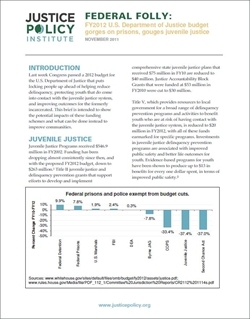
Last week Congress passed a 2012 budget for the U.S. Department of Justice that puts locking people up ahead of helping reduce delinquency, protecting youth that do come into contact with the juvenile justice system, and improving outcomes for the formerly incarcerated. This brief is intended to show the potential impacts of these funding schemes and what can be done instead to improve communities.
There are currently more than 2.4 million people incarcerated in U.S. prisons and jails, the highest per capita rate in the world. Attempting to improve public safety through increased law enforcement and correctional spending is a failed approach. If the Administration and Congress want to spend scarce federal dollars to improve public safety, they should invest in programs and policies that have been shown to have positive and long-lasting effects on individuals and communities. These programs include:
- community-based substance abuse and mental health treatment;
- evidence-based prevention programs for youth;
- employment, job skills, and education resources for underserved communities; and
- diversion programs that keep people from entering the corrections system.
Putting resources toward these positive opportunities is the most effective, and cost effective, way of increasing public safety.